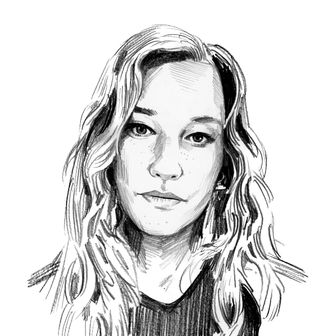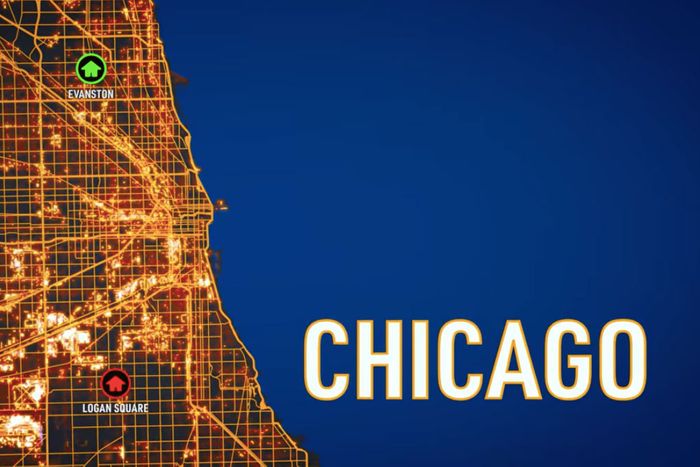
Roughly two minutes into the new Netflix holiday rom-com Holidate — starring Emma Roberts as the most terrifying person I’ve seen committed to stage or screen in decades — a graphic suddenly appears. It’s a zoomed-out heat map of Chicago and its northern suburbs, with the heat appearing to illustrate the relative densities of holiday lights (?). But only two location points are identified: Logan Square (represented by a tiny red house, and in the wrong spot on the map) and Evanston (represented by a tiny green house, and also in the wrong spot on the map). The graphic is meant to indicate that Emma Roberts’s Sloane — our alleged protagonist, whose blank-yet-furious 10,000-yard stare could decimate all wildlife in a 500-mile vicinity — is attending a dull holiday party at her family’s home in Logan Square, while just a short 30 or so minutes away, her future “holidate,” an off-brand-Hemsworth Australian named Jackson (Luke Bracey), happens to be attending a chaotic holiday party of his own in the suburb of Evanston, Illinois. I won’t insult your intelligence further by explaining the plot of this film in any additional detail.
Over the course of Holidate’s strenuous 103-minute runtime, this is the only moment when its location is referenced. From this point forward, save for an odd reference to the “L train” (nobody calls it that), there are no mentions of Chicago, no recognizable Chicago landmarks, no Chicago in-jokes — only a series of scenes that appear to be set in a city that is nothing like Chicago whatsoever, but instead some sort of Uncanny Valley Chicago, where everything is horribly lit and profoundly tragic and everyone walks around barely concealing their roiling rage. As someone who was born and raised in Chicago’s north suburbs and went on to live in Chicago proper for many years, I was alarmed by Holidate’s depiction of the city, which felt both incorrect and strangely vengeful. It felt like how someone might portray Chicago if they had only met Chicago once and then Chicago slept with his wife.
I watched with increasing horror as Sloane and Jackson spent 70 percent of the movie flirting aimlessly inside a gigantic, flat, suburban-esque mall. Chicago is not a mall city; most of its few existing malls inhabit skyscrapers, and are the sorts of malls you brace yourself to brave for a good lipstick. They’re not hangout venues where people walk around eating pretzels and sit down for meetings with family members at candy stores. I sat in quiet despondence as the pair attended dozens of theme parties in cavernous venues with stadium seating. I shuddered when they attended a Cinco de Mayo party lit entirely in purple neon where all attending patrons paused chugging tequila only to scream “shots, shots, shots.” I shivered when I realized that Sloane had absolutely no friends to speak of outside of her immediate family members and her large Australian. I became deeply disoriented when I realized that though Sloane’s mother lived in an (unlikely, one-story, suburban-y) house in Logan Square, she somehow belonged to an extremely goyishe country club. Holidate’s Chicago is a cold, cruel place, punctuated by Sartre-esque mall hangs, overzealous theme parties, and dark interactions with one’s mother over mimosas.
Afterward, I took 10 shots of tequila — a Chicago tradition — and Googled Holidate’s filming locations, anticipating that it had been shot on some soundstage in Canada to save money, which was then spent on casting Kristin Chenoweth, who is the only good part of the movie. Instead, I learned that the entire thing was shot in the city of Atlanta. I was bewildered. Nothing about Holidate’s plot dictated that the movie shouldn’t be set in Atlanta. In fact, the entire plot would make a lot more sense if it were set in Atlanta, where there is a lot more stadium seating per capita. Setting Holidate in Chicago while filming it in Atlanta implies that Chicago is not a good enough city to film a movie in, but Atlanta is too good of a city to besmirch by depicting it as the sort of place that would produce a Sloane. As Holidate’s credits rolled, I realized something: this was not the first nor the second time in recent memory that Netflix did Chicago dirty. It was, in fact, the third.
In Emily in Paris, Darren Star’s successful troll of the entire international community, Emily Cooper — whose whole thing is being so basic and unself-aware that nobody outside of the midwest can stand her — begins her Odyssean journey in her hometown of Chicago, where the show spends a total of four minutes. I’ll give Star credit for appearing to film these four minutes in the actual city of Chicago, but then I will promptly take it back, because Star makes being from Chicago seem as backwater as hailing from the hills in The Hills Have Eyes. We get our first glimpse of Emily as she runs along the lakefront in a plaid yellow puffer coat, smiling as her phone congratulates her on 5.3 miles. She is not sweating. It is ostensibly cold enough that Emily can run in a puffer without sweating, and yet, in the next scene, she is in the Loop, wearing ankle boots and a skater dress and no tights, suggesting, for the first of many times, that Emily is an idiot.
Later, Emily visits a Cubs bar in the Loop — a place where no self-respecting Chicagoan would ever socialize on purpose — where she is served a cloudy glass of white wine in a red-wine glass while surrounded by white men in button-downs and bad jeans screaming at televisions. I’ll give Star credit again: Chicago does have an overabundance of white men in button-downs and bad jeans screaming at baseball on televisions, and this scene sheds important light on this endemic problem. Laser-like accuracy aside, this is all we see of Chicago, suggesting that visiting a Cubs bar in the Loop with one’s poorly dressed boyfriend, kissing flatly when somebody scores a home run, is the only social life available to Chicagoans. In a later episode, Emily goes so far as to directly insult Lou Malnati’s, the inarguable apex of deep dish pizza in the city of Chicago, suggesting that Darren Star and Netflix not only hate Chicago, but they want to watch its institutions burn.
This Joker-esque desire to sow anarchy in the Second City dates as far back as 2018, when Netflix released The Princess Switch, starring Vanessa Hudgens as one of three suspiciously generated Vanessa Hudgens clones. The first of the clones, Stacy, owns a bakery in Chicago. The opening credits roll over recognizable Chicago locations like the State Street bridge (famously walked over by Emily Cooper), the Art Institute, and Stacy’s Sweet Treats. Yet again, The Princess Switch’s characters are only in Chicago for six minutes, reinforcing the idea that Chicago is merely a jumping off point for a much more exciting life lived somewhere else, anywhere else. And yet, the film insists on hammering the point of its brief Chicago setting not quite to death, but to something resembling it. “Your bakery is the best-kept secret in Chicago!” trills one of Stacy’s customers, which is true, as even I have never heard of it. For the duration of the film, Stacy walks around unironically wearing a baseball hat that reads “Chicago,” referencing no sports team or business, just the mere fact of the city itself. She wears this insane hat all around the city of Chicago (something that would arouse instant suspicion in real Chicago) — during winter!
All of these scenes were filmed in Romania.
Stacy, a beautiful young baker with a ponytail, cannot find anyone to date in the entirety of Chicago except for a bad-jeans button-down man named Paul who dumps her for another woman in a ponytail, implying that the men of Chicago are all terribly dressed and yet impossible to lock down. Stacy’s goddaughter, a talented ballet dancer, longs to leave Chicago to visit the made-up town of Belgravia, implying that the ballet programs in Chicago are garbage. Stacy, who embarks upon a love affair with a Belgravian prince, degrades herself as merely being a “baker from Chicago,” suggesting that even entrepreneurial Chicagoans are not worthy of being loved by someone of noble birth. Eventually, Stacy leaves Chicago entirely behind to live in Belgravia, which, again, is not real.
I list these grievous insults to Chicago not because I find Chicago to be without flaws. Chicago, like any city except for Belgravia and Atlanta, has significant room for improvement. In fact, I myself left Chicago to move to New York because Chicago quietly ate all of its own media outlets and there was nowhere left for me to work. Spending the winter in Chicago is like spending the winter in the hotel from The Shining, except with fewer vibes. Spending a summer’s night in Wrigleyville is like spending a summer’s night on the road from The Road. There is something very seriously wrong with the way that men my age in Chicago dress. Despite these glaring imperfections, Chicago does not deserve to be the mere springboard for its series of poorly drawn female protagonists in ponytails. Chicago does not deserve to be used as a lazy shorthand for a character who is down to Earth but naive, with a lot left to learn about the world. Chicago does not deserve to have its only good pizza desecrated because out-of-touch coastal elite Darren Star cannot be bothered to try Chicago pizza and realize that Giordano’s is actually the bad pizza. Chicago does not deserve to be played in a movie by Romania. Chicago deserves to be insulted intelligently and correctly, and on its own terms: In Chicago, by Chicagoans, wearing bad jeans.



